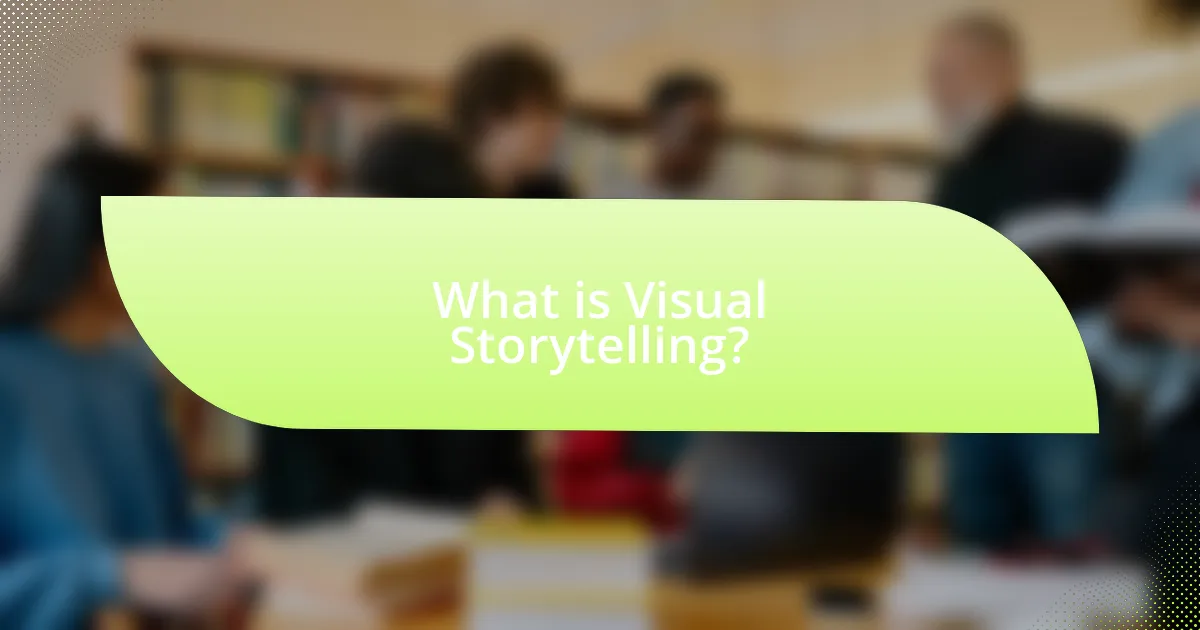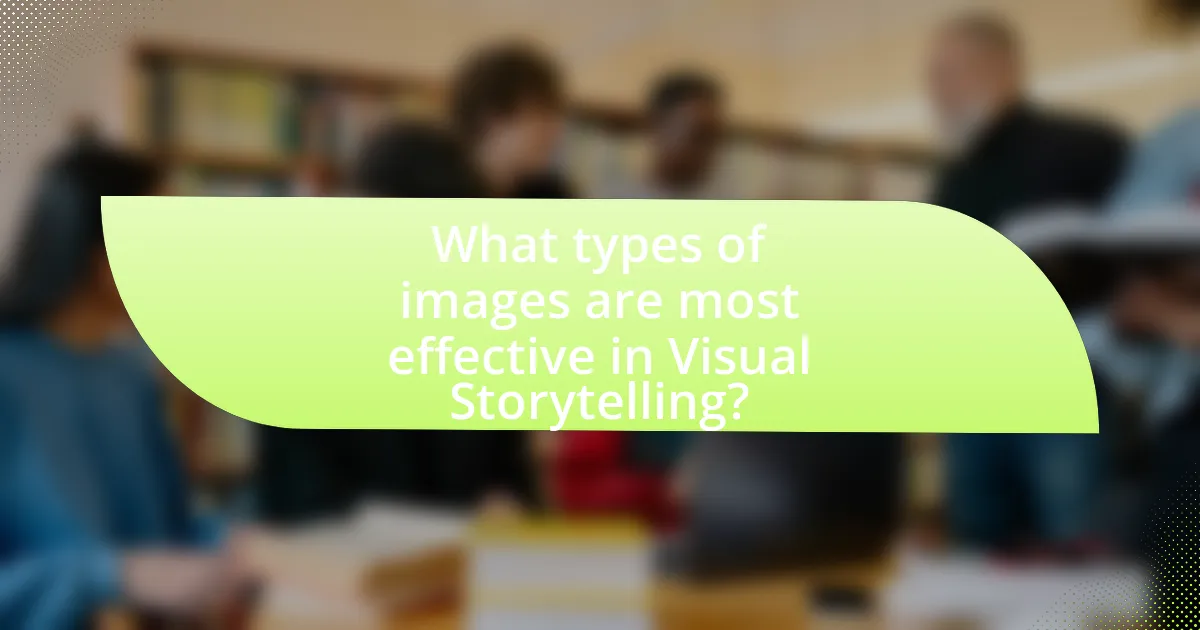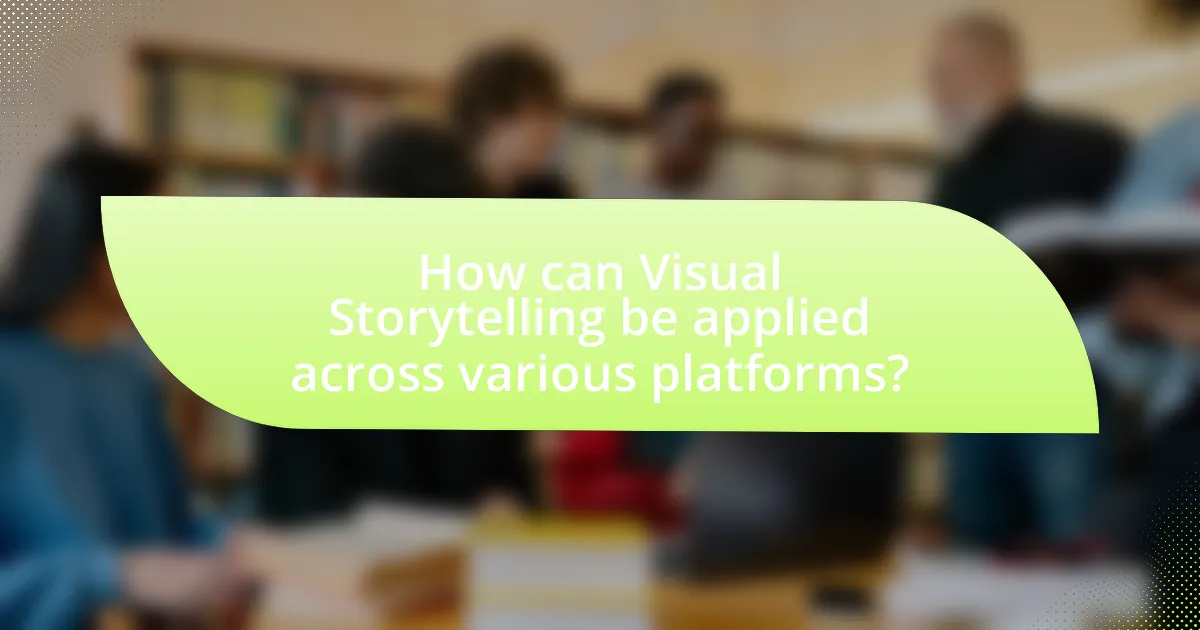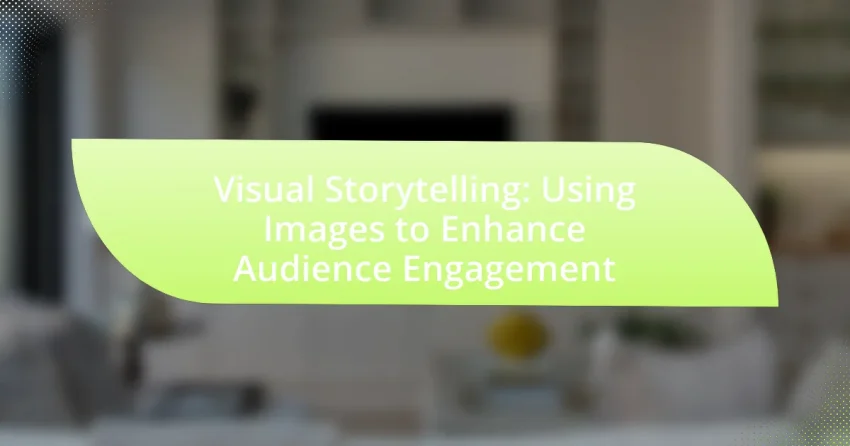Visual storytelling is the practice of using images, graphics, and visual media to convey narratives and messages, significantly enhancing audience engagement and information retention. This article explores how visual storytelling improves emotional connections, retention rates, and audience interaction by integrating strong visuals with clear narratives. Key elements of effective visual storytelling, such as emotional engagement and audience connection, are discussed, along with the impact of different image types on storytelling. Additionally, the article examines the importance of visual storytelling in today’s digital landscape, its application across various platforms, and practical tips for improving visual storytelling skills.

What is Visual Storytelling?
Visual storytelling is the use of images, graphics, and visual media to convey a narrative or message. This technique enhances audience engagement by allowing viewers to connect emotionally with the content, as studies show that visuals can increase information retention by up to 65% compared to text alone. By integrating visuals into storytelling, creators can effectively communicate complex ideas and evoke emotions, making the narrative more impactful and memorable.
How does Visual Storytelling enhance audience engagement?
Visual storytelling enhances audience engagement by creating a more immersive and relatable experience. When narratives are conveyed through images, they evoke emotions and facilitate better retention of information, as studies show that visuals are processed 60,000 times faster than text. This rapid processing allows audiences to connect with the content on a deeper level, leading to increased interest and interaction. Furthermore, research indicates that people remember 80% of what they see and do, compared to only 20% of what they read. This significant difference underscores the effectiveness of visual storytelling in capturing and maintaining audience attention.
What are the key elements of effective visual storytelling?
The key elements of effective visual storytelling include a clear narrative, strong visuals, emotional engagement, and audience connection. A clear narrative provides a structured storyline that guides the viewer through the visual content, ensuring that the message is coherent and impactful. Strong visuals, such as high-quality images or graphics, capture attention and enhance the storytelling experience by illustrating key points. Emotional engagement is crucial, as visuals that evoke feelings can create a deeper connection with the audience, making the story more memorable. Lastly, establishing an audience connection involves understanding the target demographic and tailoring the visuals to resonate with their interests and experiences, thereby increasing engagement and retention of the message.
How do visuals influence emotional responses in storytelling?
Visuals significantly influence emotional responses in storytelling by evoking feelings and enhancing narrative engagement. Research indicates that images can trigger emotional reactions more effectively than text alone, as they activate the brain’s emotional centers, such as the amygdala. For instance, a study published in the journal “Cognitive Science” by authors Paul Ekman and others demonstrates that visual stimuli can elicit immediate emotional responses, leading to a deeper connection with the story. This connection is further reinforced by the use of color, composition, and imagery, which can amplify themes and character emotions, ultimately guiding the audience’s emotional journey throughout the narrative.
Why is Visual Storytelling important in today’s digital landscape?
Visual storytelling is important in today’s digital landscape because it significantly enhances audience engagement and retention. Research indicates that visuals are processed 60,000 times faster than text, making them a powerful tool for capturing attention in a fast-paced online environment. Additionally, studies show that content with relevant images receives 94% more views than content without images, highlighting the effectiveness of visual elements in communication. This ability to convey complex information quickly and effectively is crucial for brands aiming to connect with their audience in a crowded digital space.
What role does visual content play in communication?
Visual content plays a crucial role in communication by enhancing understanding and retention of information. Research indicates that people process visuals 60,000 times faster than text, making images an effective tool for conveying complex ideas quickly. Additionally, studies show that incorporating visuals can increase engagement by up to 94%, as they capture attention and evoke emotional responses. This demonstrates that visual content not only aids in clarity but also significantly boosts audience interaction and memory recall.
How has audience behavior changed with the rise of visual media?
Audience behavior has shifted significantly with the rise of visual media, leading to increased engagement and preference for visual content over text. Research indicates that 65% of people are visual learners, which has prompted brands and content creators to prioritize images, videos, and infographics to capture attention. Additionally, platforms like Instagram and TikTok have demonstrated that users are more likely to interact with and share visual content, resulting in higher engagement rates compared to traditional text-based formats. This trend is supported by a study from HubSpot, which found that content with relevant images gets 94% more views than content without images, highlighting the effectiveness of visual media in influencing audience behavior.

What types of images are most effective in Visual Storytelling?
The most effective types of images in visual storytelling are those that evoke emotions, convey clear messages, and create a strong narrative context. Emotional images, such as portraits that capture genuine expressions, can significantly enhance audience engagement by fostering empathy. Additionally, images that depict action or movement can create a sense of urgency and excitement, drawing viewers into the story. Contextual images that provide background or setting help to ground the narrative, making it more relatable and immersive. Research indicates that visuals that combine these elements can increase retention and understanding of the story being told, as supported by studies showing that people remember 65% of information paired with relevant images compared to only 10% of information presented in text alone.
How do different image types impact storytelling?
Different image types significantly impact storytelling by influencing emotional engagement, narrative clarity, and audience perception. For instance, photographs evoke realism and authenticity, allowing viewers to connect emotionally with the subject matter, as seen in photojournalism where images of real events convey powerful narratives. Illustrations, on the other hand, can simplify complex ideas and evoke imagination, often used in children’s books to enhance understanding and engagement. Infographics combine visuals and data, making information digestible and compelling, which is crucial in educational contexts. Each image type serves a distinct purpose in storytelling, shaping how narratives are perceived and understood by audiences.
What are the benefits of using photographs versus illustrations?
Photographs provide a realistic representation of subjects, enhancing authenticity and emotional connection with the audience. This realism can evoke stronger emotional responses, as studies show that people relate more to real images than to illustrations. For instance, a survey by the Nielsen Norman Group found that users prefer photographs for their ability to convey genuine experiences, leading to higher engagement rates. In contrast, illustrations can offer stylistic flexibility and creativity, but they may lack the immediate relatability that photographs provide. Thus, the primary benefit of photographs lies in their capacity to create a more immersive and relatable visual storytelling experience.
How can infographics enhance the storytelling experience?
Infographics enhance the storytelling experience by visually representing complex information, making it easier for audiences to understand and retain key messages. Research indicates that visuals can improve comprehension by up to 400%, as they engage both the analytical and creative parts of the brain, facilitating better information processing. Additionally, infographics can condense large amounts of data into digestible formats, allowing storytellers to convey narratives more effectively and capture audience attention through appealing design elements.
What are the best practices for selecting images in storytelling?
The best practices for selecting images in storytelling include ensuring relevance, emotional resonance, and high quality. Relevant images directly support the narrative, enhancing understanding and engagement. Emotional resonance connects with the audience’s feelings, making the story more impactful. High-quality images maintain professionalism and clarity, which are crucial for audience retention. Research indicates that visuals can increase information retention by up to 65%, demonstrating the importance of effective image selection in storytelling.
How do cultural contexts affect image selection?
Cultural contexts significantly influence image selection by shaping the meanings and interpretations associated with visual content. Different cultures have unique symbols, colors, and visual narratives that resonate differently with their audiences. For instance, in Western cultures, white is often associated with purity and weddings, while in some Eastern cultures, it symbolizes mourning and funerals. This divergence in symbolism affects how images are perceived and can lead to misinterpretation if cultural nuances are overlooked. Research indicates that culturally relevant imagery enhances audience engagement, as it aligns with the viewers’ values and experiences, making the visual storytelling more impactful.
What guidelines should be followed to ensure image relevance?
To ensure image relevance, select images that directly align with the content and message being conveyed. Images should enhance understanding and engagement by visually representing key themes or concepts discussed in the text. For instance, a study by the Nielsen Norman Group indicates that relevant images can increase user engagement by up to 94%, demonstrating the importance of visual alignment with textual content. Additionally, images should be high-quality and culturally appropriate, as this further reinforces their relevance and effectiveness in communication.

How can Visual Storytelling be applied across various platforms?
Visual storytelling can be applied across various platforms by utilizing images, videos, and graphics to convey narratives that resonate with audiences. For instance, social media platforms like Instagram and Facebook leverage visual content to enhance engagement, as posts with images receive 94% more views than text-only posts. Additionally, websites and blogs can incorporate infographics and visual elements to break down complex information, making it more digestible for readers. Email marketing campaigns also benefit from visual storytelling, as emails with images can increase click-through rates by 42%. These applications demonstrate that visual storytelling effectively captures attention and communicates messages across diverse digital environments.
What strategies work best for social media visual storytelling?
Effective strategies for social media visual storytelling include using high-quality images, creating a cohesive visual theme, and leveraging user-generated content. High-quality images capture attention and convey professionalism, which is essential for engagement. A cohesive visual theme across posts helps establish brand identity and makes content recognizable, increasing the likelihood of shares and interactions. Additionally, incorporating user-generated content fosters community involvement and authenticity, as studies show that 79% of consumers say user-generated content highly impacts their purchasing decisions. These strategies collectively enhance audience engagement by making content more relatable and visually appealing.
How can brands leverage visual storytelling on Instagram?
Brands can leverage visual storytelling on Instagram by creating cohesive and engaging narratives through high-quality images and videos that resonate with their target audience. This approach allows brands to showcase their products or services in relatable contexts, enhancing emotional connections. For instance, brands like Nike utilize compelling visuals that highlight athletes’ journeys, which not only promote their products but also inspire their audience. Research indicates that posts with images receive 650% higher engagement than text-only posts, demonstrating the effectiveness of visual content in capturing attention and driving interaction.
What are effective techniques for visual storytelling in video content?
Effective techniques for visual storytelling in video content include using strong visuals, creating a narrative arc, and incorporating emotional elements. Strong visuals capture attention and convey messages quickly, while a narrative arc provides structure that guides viewers through the story. Emotional elements, such as music and character development, enhance viewer connection and engagement. Research indicates that videos with a clear narrative and emotional resonance can increase viewer retention by up to 95%, demonstrating the importance of these techniques in effective visual storytelling.
How does Visual Storytelling differ across industries?
Visual storytelling differs across industries primarily in its objectives and methods of engagement. In the marketing sector, visual storytelling focuses on brand identity and emotional connection, utilizing images and videos to evoke feelings that drive consumer behavior. For instance, brands like Nike use powerful imagery to inspire and motivate, aligning their visuals with their core message of empowerment. In contrast, the education industry employs visual storytelling to enhance learning and retention, using infographics and animations to simplify complex concepts, as seen in platforms like Khan Academy. The healthcare industry utilizes visual storytelling to communicate critical information effectively, often employing diagrams and patient stories to foster understanding and empathy, exemplified by organizations like the Mayo Clinic. Each industry tailors its visual storytelling techniques to meet specific audience needs and goals, demonstrating the versatility and adaptability of this approach.
What unique challenges do marketers face in visual storytelling?
Marketers face unique challenges in visual storytelling, primarily related to audience engagement, message clarity, and platform adaptability. Engaging diverse audiences requires marketers to create visuals that resonate emotionally while also conveying complex messages succinctly. For instance, research indicates that 65% of people are visual learners, highlighting the necessity for clarity in visuals to ensure comprehension. Additionally, different platforms have varying specifications and audience expectations, which complicates the creation of universally effective visual content. This adaptability challenge necessitates marketers to tailor their visuals for each platform while maintaining brand consistency.
How can educators utilize visual storytelling to enhance learning?
Educators can utilize visual storytelling to enhance learning by integrating images, videos, and infographics into their teaching methods. This approach engages students more effectively, as research indicates that visuals can improve information retention by up to 65% compared to text alone. By presenting complex concepts through narratives that combine visuals with relatable stories, educators can facilitate deeper understanding and emotional connections to the material. Furthermore, studies show that learners are more likely to recall information presented visually, making it a powerful tool for reinforcing key ideas and fostering critical thinking skills.
What are practical tips for improving Visual Storytelling skills?
To improve Visual Storytelling skills, focus on understanding your audience and crafting a narrative that resonates with them. Engaging visuals should complement the story, using elements like color, composition, and imagery to evoke emotions. Research indicates that visuals can increase engagement by up to 94%, highlighting the importance of effective imagery in storytelling. Additionally, practicing the art of simplicity by eliminating unnecessary details can enhance clarity and impact, making the story more memorable.
How can one develop a personal style in visual storytelling?
To develop a personal style in visual storytelling, one should consistently experiment with different techniques, themes, and visual elements that resonate personally. This process involves analyzing the work of other visual storytellers to identify unique aspects that can be adapted or reinterpreted. For instance, studying the use of color, composition, and narrative structure in successful visual stories can provide insights into effective storytelling methods. Additionally, creating a portfolio that showcases a range of styles and techniques allows for reflection and refinement of one’s unique voice. Engaging with feedback from peers and audiences further aids in honing this personal style, as it provides external perspectives on what resonates and what does not.
What tools and resources are available for aspiring visual storytellers?
Aspiring visual storytellers can utilize a variety of tools and resources to enhance their craft. Software such as Adobe Creative Cloud, which includes Photoshop and Premiere Pro, provides powerful editing capabilities for images and videos. Additionally, platforms like Canva offer user-friendly design templates that simplify the creation of visual content. Online courses from sites like Skillshare and Coursera provide structured learning on visual storytelling techniques, while books such as “The Visual Story” by Bruce Block offer foundational knowledge. Furthermore, communities on social media platforms like Instagram and Pinterest serve as inspiration and networking opportunities for visual storytellers. These resources collectively support the development of skills necessary for effective visual storytelling.
